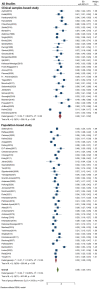Prevalence and related factors of epilepsy in children and adolescents with cerebral palsy: a systematic review and meta-analysis
- PMID: 37576141
- PMCID: PMC10416728
- DOI: 10.3389/fped.2023.1189648
Prevalence and related factors of epilepsy in children and adolescents with cerebral palsy: a systematic review and meta-analysis
Abstract
Objective: To study the worldwide prevalence and associated factors of epilepsy in children and adolescents with Cerebral Palsy (CP) and to analyze the differences between various subgroups.
Method: We identified all potential studies on the prevalence of epilepsy in children and adolescents with CP from PubMed, Web of Science, and Embase. The search time was from the establishment of the database to November 2022. Randomized effects meta-analysis models were used to calculate the prevalence of epilepsy in CP. Subgroup analysis and meta-regression were utilized to further explore heterogeneity between articles and prevalence disparities between subgroups. The funnel plot and Egger's test were used to investigate potential publication bias.
Results: Seventy-two articles, comprising 53,969 children and adolescents with CP, were included in this study. The results indicated a total epilepsy prevalence of 38.0% (95% CI: 34.8%-41.2%) in CP. The prevalence of epilepsy was 46.4% (95% CI: 41.4%-51.5%) in clinical sample-based studies and 31.6% (95% CI: 28.7%-34.5%) in population-based studies. Meta-regression demonstrated that the sample source, neonatal seizure, family history of epilepsy, EEG or cranial imaging abnormalities, intellectual/cognitive impairment, and topographical types of CP were heterogeneous contributors to the epilepsy prevalence in CP.
Conclusion: Approximately one-third of children and adolescents with CP have epilepsy, and the sample source can significantly impact the total prevalence of epilepsy. Neonatal seizures, family history of epilepsy, EEG abnormalities, cranial imaging abnormalities, severe intellectual disability, and quadriplegia may be contributing factors to epilepsy comorbid in CP. Further study is required to verify the strength of these associations with epilepsy. This study aids in identifying the clinical characteristics of young people with CP at risk of developing epilepsy, which may assist clinicians in the early prevention and diagnosis of epilepsy within this population.Systematic Review Registration: https://www.crd.york.ac.uk/PROSPERO/display_record.php?RecordID=367766, identifier CRD42022367766.
Keywords: cerebral palsy; children; epilepsy; meta-analyses; prevalence.
© 2023 Gong, Liu, Lian, Wu, Zeng, Hao, Wang, Jiang, Pang, Guo and Zhou.
Conflict of interest statement
The authors declare that the research was conducted in the absence of any commercial or financial relationships that could be construed as a potential conflict of interest.
Figures





Similar articles
-
Prevalence of cerebral palsy comorbidities in China: a systematic review and meta-analysis.Front Neurol. 2023 Sep 28;14:1233700. doi: 10.3389/fneur.2023.1233700. eCollection 2023. Front Neurol. 2023. PMID: 37840931 Free PMC article.
-
Health-related quality of life and associated factors among epilepsy patients in sub-Saharan Africa: a systematic review and meta-analysis.Front Neurol. 2025 Mar 5;16:1546911. doi: 10.3389/fneur.2025.1546911. eCollection 2025. Front Neurol. 2025. PMID: 40109845 Free PMC article.
-
Mental Health in COVID-19 Pandemic: A Meta-Review of Prevalence Meta-Analyses.Front Psychol. 2021 Sep 21;12:703838. doi: 10.3389/fpsyg.2021.703838. eCollection 2021. Front Psychol. 2021. PMID: 34621212 Free PMC article.
-
The Potential Role of Previous Physical Exercise Program to Reduce Seizure Susceptibility: A Systematic Review and Meta-Analysis of Animal Studies.Front Neurol. 2021 Dec 10;12:771123. doi: 10.3389/fneur.2021.771123. eCollection 2021. Front Neurol. 2021. PMID: 34956052 Free PMC article.
-
Risk Factor Predictors for Developing Epilepsy in Cerebral Palsy Patients in a Tertiary Hospital in Saudi Arabia: A Retrospective Study.Cureus. 2024 May 9;16(5):e59980. doi: 10.7759/cureus.59980. eCollection 2024 May. Cureus. 2024. PMID: 38854260 Free PMC article.
Cited by
-
Tranexamic acid in hip and spine surgery for children with cerebral palsy - a PRISMA-compliant scoping review.Syst Rev. 2024 Dec 27;13(1):315. doi: 10.1186/s13643-024-02734-7. Syst Rev. 2024. PMID: 39731199 Free PMC article.
-
Functioning profile and related impairments of children and adolescents with cerebral palsy - PartiCipa Brazil preliminary results.BMC Pediatr. 2024 Nov 11;24(1):719. doi: 10.1186/s12887-024-05210-2. BMC Pediatr. 2024. PMID: 39529069 Free PMC article.
-
Risperidone-Induced Hypothermia in a Cerebral Palsy Patient: A Case Report and Literature Review.Cureus. 2024 Dec 24;16(12):e76321. doi: 10.7759/cureus.76321. eCollection 2024 Dec. Cureus. 2024. PMID: 39850186 Free PMC article.
-
Knowledge, attitude and practice of rehabilitation management of the caregivers of pediatric patients with hemiplegia.Sci Rep. 2025 May 28;15(1):18756. doi: 10.1038/s41598-025-03223-0. Sci Rep. 2025. PMID: 40437051 Free PMC article.
References
-
- Rosenbaum P, Paneth N, Leviton A, Goldstein M, Bax M, Damiano D, et al. A report: the definition and classification of CP April 2006. Dev Med Child Neurol Suppl. (2007) 109:8–14. - PubMed
-
- Centers for disease control and prevention. Data and statistics for CP (2021). Available at: https://www.cdc.gov/ncbddd/cp/data.html (Accessed May, 2021).
Publication types
LinkOut - more resources
Full Text Sources
Miscellaneous

